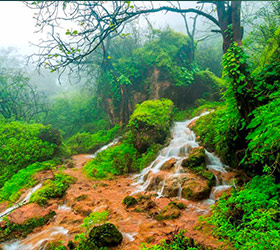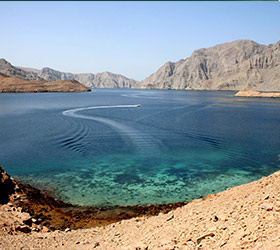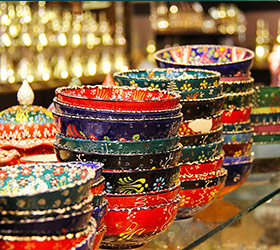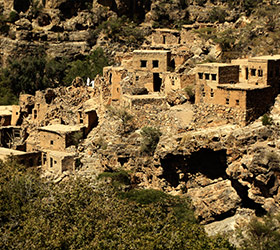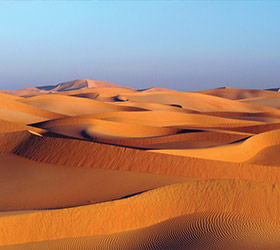Oman
All Destinations
Oman
With breathtaking scenery, excellent hospitality and impeccable service, the Sultanate of Oman is an ideal option for holidays of all types.
Constantly surprising and always inspiring, this ruggedly beautiful land of wonder and mystery resonates with history and culture. From the buzzing markets of Muscat to the majestic Sultan Qaboos Grand Mosque, Oman captivates guests with its alluring diversity. The striking mountains of Nizwa, the fjords of Mussandam and the lush southern areas around Salalah ensure stunning backdrops for a wide variety of explorations.
For those after the convenience of Dubai’s location less the glitz, Oman makes for a wonderful alternative. With no high rise construction, the sultanate has remained unspoilt and true to its Arabic heritage and you needn’t travel far from your hotel to meet locals whose lives have remained largely unchanged from those of their great grandparents.
Beach hotels are small in number, yet spectacular in structure and situation. The mountainous coastline is home to secluded bays which play host to luxurious and impressive resorts, boasting award winning spas, superb dining and a variety of water sports, including some exceptional diving opportunities.
Families are well catered for with a variety of child friendly activities on offer. A nights camping in the desert will satisfy a young adventurers curiosity, while beaches popular with nesting turtles will entrance the junior wildlife enthusiast. A small, yet well facilitated selection of beach hotels, are particularly suitable for little ones with kids clubs, water sports and babysitting available, allowing parents to remind themselves that it’s their holiday too.
With a variety of spectacular terrain, authentic hospitality and a reassuringly safe environment, Oman is the ideal destination for those seeking a genuine adventure, without sacrificing comfort.
Quick Facts
Capital
Muscat
Population
2.9 million
Area
309,500 sq km (119,500 sq miles)
Major Languages
Arabic
Major religion
Islam
Monetary Unit
Rial
Flight time from London
7.5 hours
Time Difference
GMT + 4
When to go
Oman is best visited in the winter months while in the summer, temperatures can rise significantly above 40C and humidity can be high. From October through to April, it is a wonderfully pleasant place to visit, temperatures sitting comfortably in the twenties, rising into the thirties in the autumn and late spring.
Rain is fleeting and tends only to come in the middle of the winter as short, sharp showers.
In the mountains, temperatures are considerably cooler than the coast. From June to September, wet winds create a thick fog that coats the mountains which deposits moisture on the vegetation and ground creating luxuriant green hills.
Salalah has a very different climate in that it has a monsoon season, called the Khareef, running from June to September for which many towns are reliant upon for their water supply.
- J
- F
- M
- A
- M
- J
- J
- A
- S
- O
- N
- D
- High Season
- Mid Season
- Shoulder Season
Highlights





Dhofar and Salalah
Famous for its frankincense and greenery thanks to it’s khareef (monsoon), Salalah is the capital city of Oman’s southern Zufar and Dhofar region and is the birthplace of the current Sultan Qaboos.
During the peak summer months, when the rest of the country is uncomfortably hot, the khareef keeps Salalah cool and green, acting as a welcome retreat to Omani’s from the north. Sitting on a long sandy beach, lined with lush green palm trees, it’s hard to imagine the desert lies just a few kilometres away.
The town of Salalah offers vegetable and fish markets as well as the frankincense souq , all well worth visiting for a taste of local life.
Venturing out from the town, dramatic scenery, dominating mountains, home to the Jiballi tribe, untouched beaches, traditional fishing villages and picturesque small fortified towns all warrant spending some time exploring the area. Notably worth visiting is Mughsayl, famous for its giant blowholes on the cliff tops and Khor Rawri, an archaeological site dating to the 1st century AD and creek, low in salt content attracting a multitude of fish and bird species.
The beautiful and awe inspiring Empty Quarter makes for the ultimate in desert escape and a photographer’s paradise.






Musandam Peninsula
Musandam is on the Strait of Hormuz, separated from the rest of Oman by the east coastline of the United Arab Emirates. Here barren mountains rise up to 2,000 metres or 6,500 feet above sea level jut out like fingers into the sea, creating countless fjord-like inlets, yielding spectacular views.
The mountains have housed extremely isolated communities for centuries and many coastal villages can still only be reached by boat. The population of approximately 29,000 is concentrated in the capital Khasab in the north, and the small port town of Dibba on the east coast.
Due to the sparse population of the Musandam Peninsula coast, wildlife, including bottlenose dolphins, sea turtles and various types of birds, is abundant in the waters along the coast. Musandam is, in a more romantic description, an outdoor aquarium presenting fish of brilliant colours in their natural setting of green and blue corals.
A number of historical and archaeological sites can be found in this area, each of which has a story of its own. The Khasab Port takes its name from its fertile soil, according to the elders in this area and is famous for its magnificent villages and the thrilling roads leading to mountain tops.
One of the major attractions is the Telegraph Island which was the location of a British repeater station used to boost telegraphic messages along the Persian Gulf submarine cable. It was not an easy posting for the operators, with the severe summer heat and hostility of local tribes making life extremely uncomfortable. Because of this, the island is, according to some, where the expression “go round the bend” comes from, a reference to the heat making British officers desperate to return to civilization, which meant a voyage around the bend in the Strait of Hormuz back to India.




Muscat
Muscat today is in fact three smaller towns which have grown together over time. Muscat, often referred to as the “walled city”, the site of the royal palaces, Matrah, originally a fishing village and home to the maze-like Matrah Souq and Ruwi – generally considered the commercial and diplomatic centre of the city.
Within the city the Sultan Qaboos Grand Mosque is the third largest mosque in the world showing off its Swarovski crystal chandelier, the second largest handmade Persian carpet in the world and exquisite marble panelling.
The Nakhal Fort is about 40 minutes drive east of the city, located at the base of the Jebel Akhdar section of the Hajar Mountains. Wadi Shab. This is perhaps the most spectacular of all the easily accessible wadis in Oman. It is located about 100 km southeast of Muscat, accessed from the main coastal road to Sur at the village of Tiwi. The pools here are a vivid Emerald Green colour, and the caves and sheer sides of the wadi really dramatic.
Along the beach road from Qurum to Seeb, you’ll discover the true beauty of the Oman coast-line. Kilometres of beaches, fisherman with drag nets and open space to walk for hours. The coast offers the opportunity for some spectacular diving, turtle watching and dolphin safari’s.
The proximity of the coast to the mountains and desert means day trips, night safaris, trekking and rock climbing are available from a beach based hotel.







Nizwa and Jebel Akdar
Nizwa was the capital of Oman in the 6th and 7th century. In the 17th century an imposing fort, was built by Sultan Bin Saif Al Ya’ribi. The fort remains the most visited monument in Oman today.
Nizwa souq sells jewelry, muskets and khunjars (traditional curved knives worn by men) but best of all is the auction held every Friday where locals come to proudly parade their livestock for sale in a vibrant environment full of colour, elegance and tradition.
The fantastically well restored fort of Jabreen, lies north of Nizwa and is often thought to be the country’s most impressive. Well stocked with period artifacts it provides and accurate representation of life for its original inhabitants.
Bahla, a huge fort south of Nizwa is a UNESCO World Heritage Site, towering 50m above the surrounding village. Having received little attention or restoration it is wonderful example of ancient building techniques.
The northern section of the Hajar Mountains is known as Jebel Akdar, meaning Green Mountain. Jebel Shams is the highest peak in Oman at about 3,000m. Wadi Ghul, Oman’s Grand Canyon, can be viewed from a wide plateau as you approach the summit, demonstrating a drop of over a kilometre to its base.
The dramatic mountain scenery provides a beautiful area to explore with a host of activities; walks for geology and flora enthusiasts, visits to traditional mountain villages, Al Hoota Caves, Wadi Bani Awf and the opportunity to meet local people, gaining an insight into the local way of life.







Sharqiya (Wahiba) Sands
Named after the Wahiba tribe, the Wahiba Sands, or Ramlat al-Wahiba (also called Sharqiya Sands), is a region of desert in Oman with an area of 12,500 square kilometers (4,800 sq mi), just four hours’ drive from Muscat.
A diverse terrain, the flora and fauna of the area includes no less than16,000 invertebrates as well as 200 species of other wildlife, including avifauna and 150 species of native flora.
The desert was formed during the Quaternary period as a result of the forces of south-west blowing monsoon and the northern shamal trade wind, coming in from the east. Based on the types of dunes found in the area, it is divided into the high, or upper, Wahiba and low Wahiba.
The upper area contains mega-ridge sand systems on a north-south line that are believed to have been formed by monsoon. The dunes of the north, formed at some point after the last regional glaciation, measure up to 100 meters (330 ft) high, with peaks accumulating in the areas just beyond the strongest wind speeds, where declining velocity wind deposited sand.
The area is occupied by Bedouins who congregate at Al Huyawah, an oasis near the border of the desert, between June and September to gather dates. Camel racing and breeding is a way of life and livelihood in the area and a visit to a race is a must during your stay.
Due to its location, including Wahiba on your itinerary means to you can travel via traditional villages, old forts, castles and 3,200 BC tombs, not to mention numerous ‘wadis’ and canyons for swimming and picnicking. Located on the Eastern peninsula an hour from the desert, Ras al Jinz is home to a turtle reserve, a stop well worth including for wildlife enthusiasts and children in particular.





Dhofar and Salalah
Famous for its frankincense and greenery thanks to it’s khareef (monsoon), Salalah is the capital city of Oman’s southern Zufar and Dhofar region and is the birthplace of the current Sultan Qaboos.
During the peak summer months, when the rest of the country is uncomfortably hot, the khareef keeps Salalah cool and green, acting as a welcome retreat to Omani’s from the north. Sitting on a long sandy beach, lined with lush green palm trees, it’s hard to imagine the desert lies just a few kilometres away.
The town of Salalah offers vegetable and fish markets as well as the frankincense souq , all well worth visiting for a taste of local life.
Venturing out from the town, dramatic scenery, dominating mountains, home to the Jiballi tribe, untouched beaches, traditional fishing villages and picturesque small fortified towns all warrant spending some time exploring the area. Notably worth visiting is Mughsayl, famous for its giant blowholes on the cliff tops and Khor Rawri, an archaeological site dating to the 1st century AD and creek, low in salt content attracting a multitude of fish and bird species.
The beautiful and awe inspiring Empty Quarter makes for the ultimate in desert escape and a photographer’s paradise.






Musandam Peninsula
Musandam is on the Strait of Hormuz, separated from the rest of Oman by the east coastline of the United Arab Emirates. Here barren mountains rise up to 2,000 metres or 6,500 feet above sea level jut out like fingers into the sea, creating countless fjord-like inlets, yielding spectacular views.
The mountains have housed extremely isolated communities for centuries and many coastal villages can still only be reached by boat. The population of approximately 29,000 is concentrated in the capital Khasab in the north, and the small port town of Dibba on the east coast.
Due to the sparse population of the Musandam Peninsula coast, wildlife, including bottlenose dolphins, sea turtles and various types of birds, is abundant in the waters along the coast. Musandam is, in a more romantic description, an outdoor aquarium presenting fish of brilliant colours in their natural setting of green and blue corals.
A number of historical and archaeological sites can be found in this area, each of which has a story of its own. The Khasab Port takes its name from its fertile soil, according to the elders in this area and is famous for its magnificent villages and the thrilling roads leading to mountain tops.
One of the major attractions is the Telegraph Island which was the location of a British repeater station used to boost telegraphic messages along the Persian Gulf submarine cable. It was not an easy posting for the operators, with the severe summer heat and hostility of local tribes making life extremely uncomfortable. Because of this, the island is, according to some, where the expression “go round the bend” comes from, a reference to the heat making British officers desperate to return to civilization, which meant a voyage around the bend in the Strait of Hormuz back to India.




Muscat
Muscat today is in fact three smaller towns which have grown together over time. Muscat, often referred to as the “walled city”, the site of the royal palaces, Matrah, originally a fishing village and home to the maze-like Matrah Souq and Ruwi – generally considered the commercial and diplomatic centre of the city.
Within the city the Sultan Qaboos Grand Mosque is the third largest mosque in the world showing off its Swarovski crystal chandelier, the second largest handmade Persian carpet in the world and exquisite marble panelling.
The Nakhal Fort is about 40 minutes drive east of the city, located at the base of the Jebel Akhdar section of the Hajar Mountains. Wadi Shab. This is perhaps the most spectacular of all the easily accessible wadis in Oman. It is located about 100 km southeast of Muscat, accessed from the main coastal road to Sur at the village of Tiwi. The pools here are a vivid Emerald Green colour, and the caves and sheer sides of the wadi really dramatic.
Along the beach road from Qurum to Seeb, you’ll discover the true beauty of the Oman coast-line. Kilometres of beaches, fisherman with drag nets and open space to walk for hours. The coast offers the opportunity for some spectacular diving, turtle watching and dolphin safari’s.
The proximity of the coast to the mountains and desert means day trips, night safaris, trekking and rock climbing are available from a beach based hotel.







Nizwa and Jebel Akdar
Nizwa was the capital of Oman in the 6th and 7th century. In the 17th century an imposing fort, was built by Sultan Bin Saif Al Ya’ribi. The fort remains the most visited monument in Oman today.
Nizwa souq sells jewelry, muskets and khunjars (traditional curved knives worn by men) but best of all is the auction held every Friday where locals come to proudly parade their livestock for sale in a vibrant environment full of colour, elegance and tradition.
The fantastically well restored fort of Jabreen, lies north of Nizwa and is often thought to be the country’s most impressive. Well stocked with period artifacts it provides and accurate representation of life for its original inhabitants.
Bahla, a huge fort south of Nizwa is a UNESCO World Heritage Site, towering 50m above the surrounding village. Having received little attention or restoration it is wonderful example of ancient building techniques.
The northern section of the Hajar Mountains is known as Jebel Akdar, meaning Green Mountain. Jebel Shams is the highest peak in Oman at about 3,000m. Wadi Ghul, Oman’s Grand Canyon, can be viewed from a wide plateau as you approach the summit, demonstrating a drop of over a kilometre to its base.
The dramatic mountain scenery provides a beautiful area to explore with a host of activities; walks for geology and flora enthusiasts, visits to traditional mountain villages, Al Hoota Caves, Wadi Bani Awf and the opportunity to meet local people, gaining an insight into the local way of life.







Sharqiya (Wahiba) Sands
Named after the Wahiba tribe, the Wahiba Sands, or Ramlat al-Wahiba (also called Sharqiya Sands), is a region of desert in Oman with an area of 12,500 square kilometers (4,800 sq mi), just four hours’ drive from Muscat.
A diverse terrain, the flora and fauna of the area includes no less than16,000 invertebrates as well as 200 species of other wildlife, including avifauna and 150 species of native flora.
The desert was formed during the Quaternary period as a result of the forces of south-west blowing monsoon and the northern shamal trade wind, coming in from the east. Based on the types of dunes found in the area, it is divided into the high, or upper, Wahiba and low Wahiba.
The upper area contains mega-ridge sand systems on a north-south line that are believed to have been formed by monsoon. The dunes of the north, formed at some point after the last regional glaciation, measure up to 100 meters (330 ft) high, with peaks accumulating in the areas just beyond the strongest wind speeds, where declining velocity wind deposited sand.
The area is occupied by Bedouins who congregate at Al Huyawah, an oasis near the border of the desert, between June and September to gather dates. Camel racing and breeding is a way of life and livelihood in the area and a visit to a race is a must during your stay.
Due to its location, including Wahiba on your itinerary means to you can travel via traditional villages, old forts, castles and 3,200 BC tombs, not to mention numerous ‘wadis’ and canyons for swimming and picnicking. Located on the Eastern peninsula an hour from the desert, Ras al Jinz is home to a turtle reserve, a stop well worth including for wildlife enthusiasts and children in particular.
Where to stay
These are just a selection of the properties we can personally recommend. Please get in touch to hear more about our full portfolio.
Al Baleed Resort Salalah by Anantara
Between a beach and freshwater lagoon, Al Baleed Resort Salalah by Anantara offers refreshing luxury, and also a gateway to Oman’s cultural treasures. It is a beachfront oasis that is the first luxury villa resort of its kind in Salalah, along the south coast of Dhofar.
Al Bustan Palace
An iconic Omani hotel, built in 1985 for the GCC Summit, delivering opulence and luxurious surroundings expected of Middle Eastern Heads of State. With 1km of private beachfront, the longest in Oman, and extensive facilities found within the beautiful gardens, Al Bustan Palace provides ample opportunities to relax and entertain. 250 rooms and suites seamlessly […]
Alila Jabal Akhdar
Jabal Akhdar, meaning “The Green Mountain” in Arabic, is part of the Al Hajar mountain range, one of Oman’s most spectacular regions. Perched here 2,000 metres above sea level, Alila Jabal Akhdar overlooks a dramatic gorge, surrounded by awe-inspiring views of the mountains.
Private Luxury Camping
Private Luxury Camps combine the experience of a traditional caravan campsite, a tradition of the Bedouins dating back to prehistoric times, with the comfort of high luxury accommodation of the 21st Century. The camps are eco-friendly, with a firm belief in sustainable travel, using solar energy, limiting water wastage and dry loos.
Shangri-La Barr Al Jissah Resort and Spa
Shangri-La’s Barr Al Jissah Resort and Spa comprises a total of three hotels, catering for myriad of travellers and parties from young families to young-at-heart couples. The family friendly Al Waha offers several swimming pools set among date palms while Al Bandar has been designed to reflect a small town with a variety of fine restaurants.
Six Senses Zighy Bay
Six Senses Zighy Bay is located on the northern Musandam Peninsula in the Sultanate of Oman. The setting of these 82 indigenous village-style pool villa accommodations is spectacular, guarded by the dramatic Hajar Mountains and private sandy beach.
The Chedi Muscat
Where the majestic Al Hajar Mountains meet their reflection in the serene waters of the Gulf of Oman, the Chedi rises amidst an elegantly landscaped twenty-one acre garden oasis, set on the shores of the city of Muscat. The Chedi Muscat’s sublime yet central location suits leisure and business travellers equally.
Get in touch with us now to start planning your journey
Follow Us
Proudly ASSOCIATED WITH








